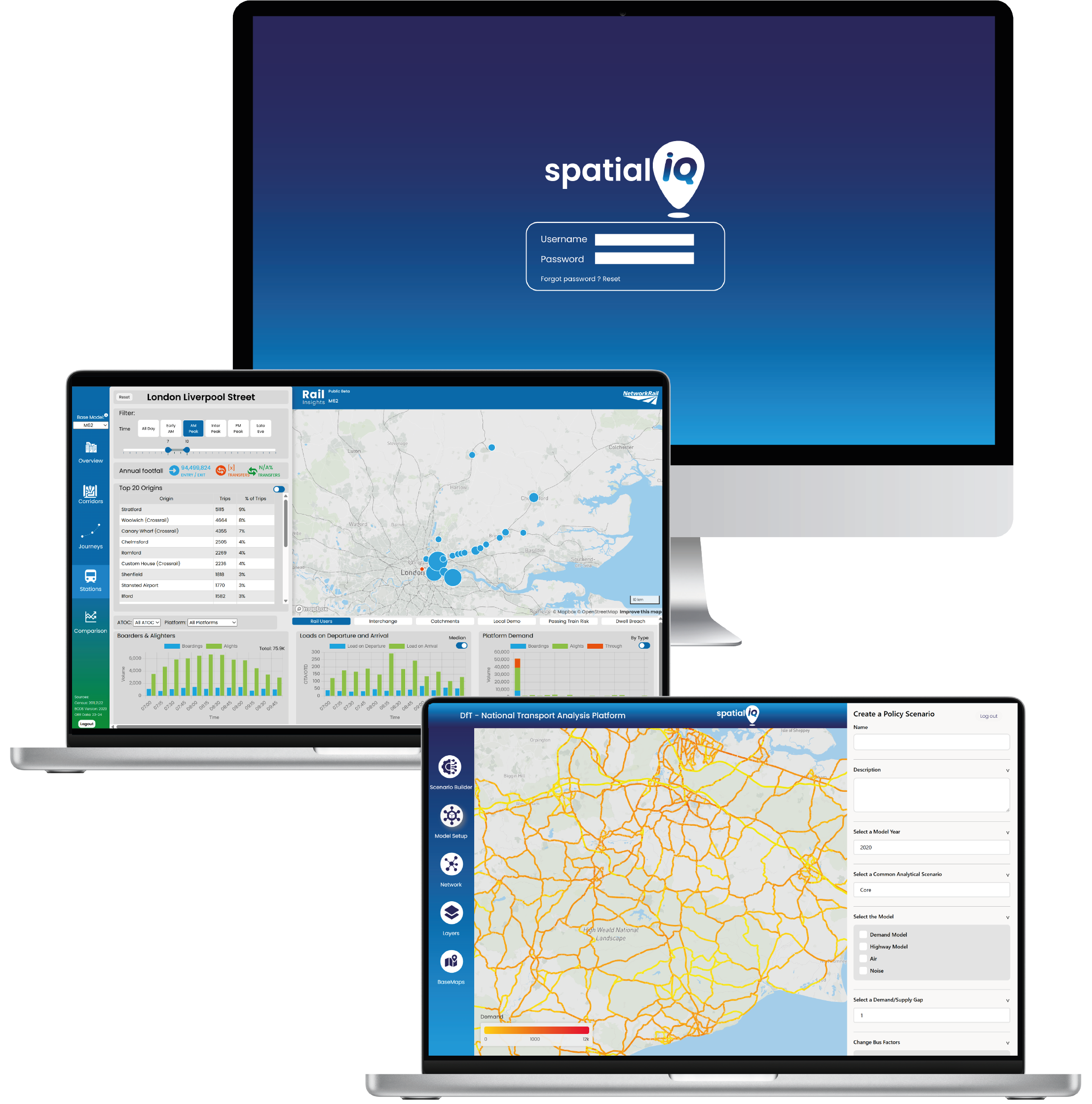

National Transport Analysis Platform (NTAP)
This page provides access to the Spatial IQ Demonstration Platform, and evidence of running the PTV Visum Demonstration Model (a large-scale 4-stage transport model with integrated air and noise models), created as part of the National Transport Analysis Platform (NTAP) procurement process.

DEMO: Spatial IQ Demonstration Platform
Operating Instructions for the Platform Demo
The primary objective of the platform demo is to show ease of use, integrated data pipelines and automation, and how user intervention is not required once the scenario parameters have been set.
We recommend the following steps:
Click “Launch NTAP demo below to open the NTAP Spatial IQ Demonstration Platform.
Log in with the credientials below.
A Visum base model will automatically load (note: this model is smaller than the PTV Visum Demonstration Model, which is shown in the video below, but for the PoC we will use a model of equivalent size to NTMv5).
Navigate to the Scenario Builder interface.
Create a policy scenario: Configure run parameters, including Forecast Year, Common Analytical Scenarios and Modules, as well as adjusting Bus and Rail Factors (note: we will tailor the run parameters to the DfT's needs for the PoC).
Press Save the Scenario.
Click Build the Scenario to submit the scenario to be modelled.
Visum will commence immediately and start running your model.
If another model is already running, another instance will be launched (up to 2) to demonstrate scalabaility.
Completion time: one full run (10 iterations) typically completes within 30 minutes (note: for this demo platform only, please do not exit the browser or attempt to make further changes while the model is running).
On completion Spatial IQ will respond and visualise the results. Note that although a tailored model is being run in the back-end, not all visualisations are linked to that model in the demo version. The frontend will be tailor to meet the specific needs of the DfT.
All previously run scenarios can be quickly recalled via Scenario Loader
USERNAME1 : ntap1@spatialdesignhub.com
USERNAME2 : ntap2@spatialdesignhub.com
PASSWORD: ntap2025
Spatial IQ Scenario Execution and integration with Visum
The video below demonstrates how Spatial IQ integrates directly with PTV Visum, enabling a model run to be configured and executed entirely through the frontend application. The demo interface allows users to adjust scenario parameters, follow the steps to initiate a model run, and use the Scenario Loader to recall previously executed runs.
At this stage, the user interface is provided purely for demonstration purposes. The interaction and charts shown in the demo are conceptual only and do not yet reflect the model outputs. As part of the Proof of Concept, the UI will be fully developed to align with the Department for Transport’s requirements and present results directly from VISUM.
This evidences Spatial IQ’s ability to run VISUM seamlessly through the web platform and return results without manual intervention, while providing a clear pathway for interface development in the PoC phase.
A key requirement for NTAP is not only the ease-of-use, but speed of model runtime. In preparation for NTAP we have created a Visum example model, as shown in this video, with an optimised implementation that can complete 10 demand/supply iterations in under 30 minutes. This example model has more than 70,000 links, 4,000 zones, 5 assigned user classes and a variable (nested) demand model structure aligned with NTMv5 and TAG. Noise levels and pollutants are calculated automatically based on highway assignment outputs.
This example model is implemented using Visum Desktop. For NTAP, we will integrate the developer version of Visum called Visum Library which will run models in the backend of Spatial IQ. Visum Library has the same functionality as Desktop but is designed for developers and integration. Importantly for NTAP, Library also has shorter runtimes. This is why we are confident of running a model of the scale of NTM also in under 30 minutes once integrated into the platform.
PTV Visum Demonstration Model
Demonstrating Scalability
To meet NTAP requirements for performance and responsiveness, we will deliver a scalable backend architecture fully controlled via the Spatial IQ frontend. Users will be able to configure and launch model runs with just a few clicks, without requiring any manual interaction with the underlying Visum environment.
Our approach includes:
Scheduling capability: allowing users to queue multiple model runs directly from the Spatial IQ interface. Runs will be executed in sequence, with clear visibility of their position in the queue and expected completion time.
Parallelisation capability: enabling users to initiate multiple high-performance virtual machines (VMs) directly from the frontend. This will allow multiple Visum model runs to be executed concurrently within roughly the same time as it takes to run one.
To illustrate this approach, the video here shows the Spatial IQ frontend triggering the backend to automatically fire up two Visum instances concurrently and execute the modelling sequence. This evidences not only the scalability of the system, but also the simplicity of operation; placing powerful modelling capabilities in the hands of end users through a streamlined, web-based interface.




